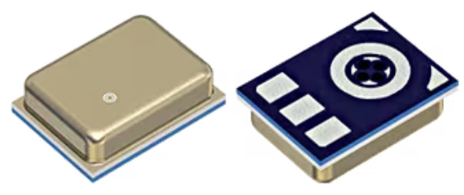Electromagnetic susceptibility of MEMS microphones
The project aims to understand the effect of interfering, high-frequency coupling in a microphone that is installed in a mobile device (e.g. smartphone, tablet) and to reduce it using suitable measures. The coupling is caused, for example, by non-linear effects in the diodes and transistors of the ASICs, thermoacoustic effects, e.g. through periodic heating of the ASIC and the resulting pressure changes in the acoustic back volume of the microphone or coupling through magnetic forces on ferromagnetic components of the housing or through eddy currents in conductive materials.
To reduce the acoustic interference signals, electromagnetic low-pass filters are used next to or in the MEMS microphones, which are either realized from discrete components on the circuit board of the system or integrated into the microphones.
The project therefore aims to use simulations and measurements to identify and quantitatively describe the main effects that lead to the acoustic interference.
Project background
We are all using more and more devices that have radio frequency (RF) interfaces and microphones, especially smartphones, wireless headphones, tablets and smart speakers. A major problem that makes the development of these devices increasingly difficult is the coupling of RF signals into the acoustic signal path, which leads to audible interference. The best-known example of this is interference from GSM signals, known as bumblebee noise. The GSM RF signal, which is periodic at 217 Hz, causes interference that sounds like the buzzing of a bumblebee.
As the number of radio interfaces supported by devices increases, however, it is becoming increasingly difficult to avoid interference. New frequencies and new modulation methods due to 5G and new WLAN standards often lead to new problems.
Project objective
The project aims to identify and quantitatively describe the main effects that lead to acoustic interference. Based on this, measures will then be developed to reduce the coupling, which the industrial partner TDK can use after the end of the project to develop microphones with a lower sensitivity to interference.
Project procedure
After the first year of the project, functional measuring stations will be set up to determine the influence of high-frequency interference on the audio line of a microphone. At the same time, reliable simulation models will be created using the finite element method and the lumped element method, which can be used to calculate the influence of high-frequency interference. One and a half years after the start of the project, the dominant coupling effects should be understood and a concept for improved microphone housings developed on this basis. Test microphones will then be produced and examined with regard to their sensitivity to high-frequency interference.
Innovation
For the first time, the coupling effects of high-frequency interferers on micro-mechanical microphones are being systematically investigated. This should facilitate the development process for new consumer devices that use these microphones in the future.
Overall lead for THRO input
Sub-project lead
Hochschule München
Project staff
External project collaboration
Project duration
2023-10-01 - 2026-09-30Project partners
Project funding

Funding programme
FH Kooperativ


